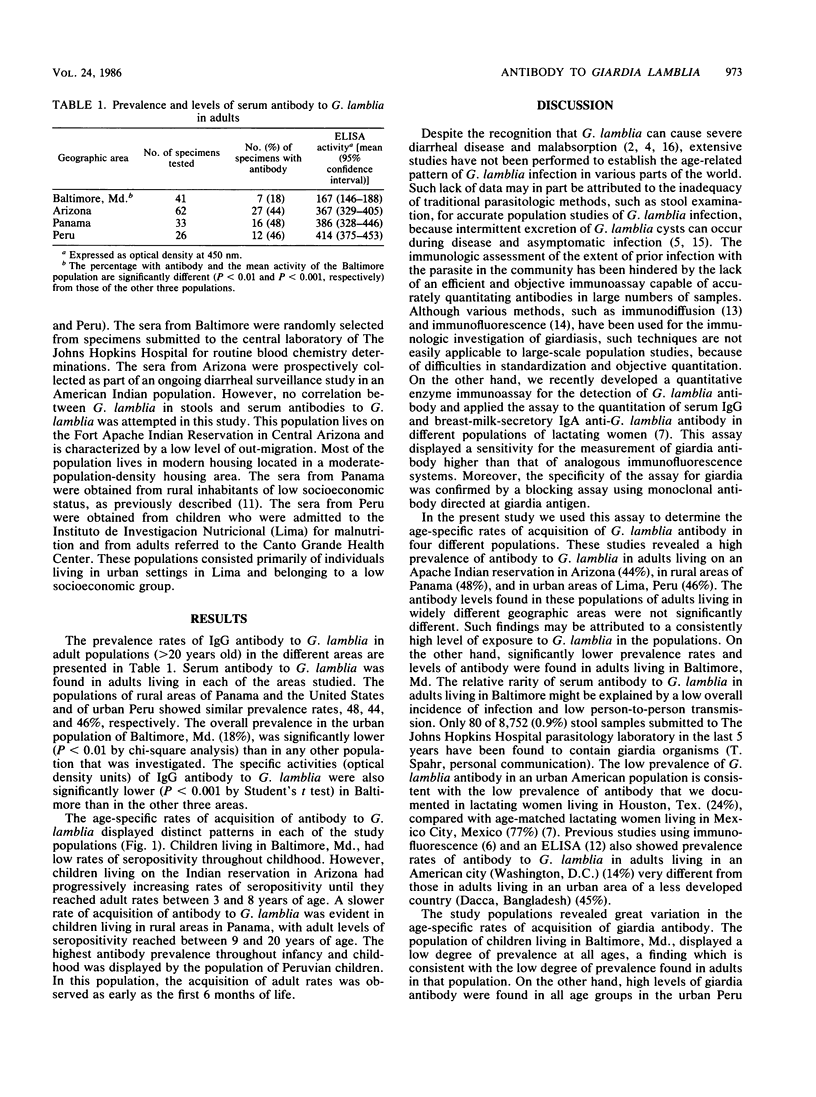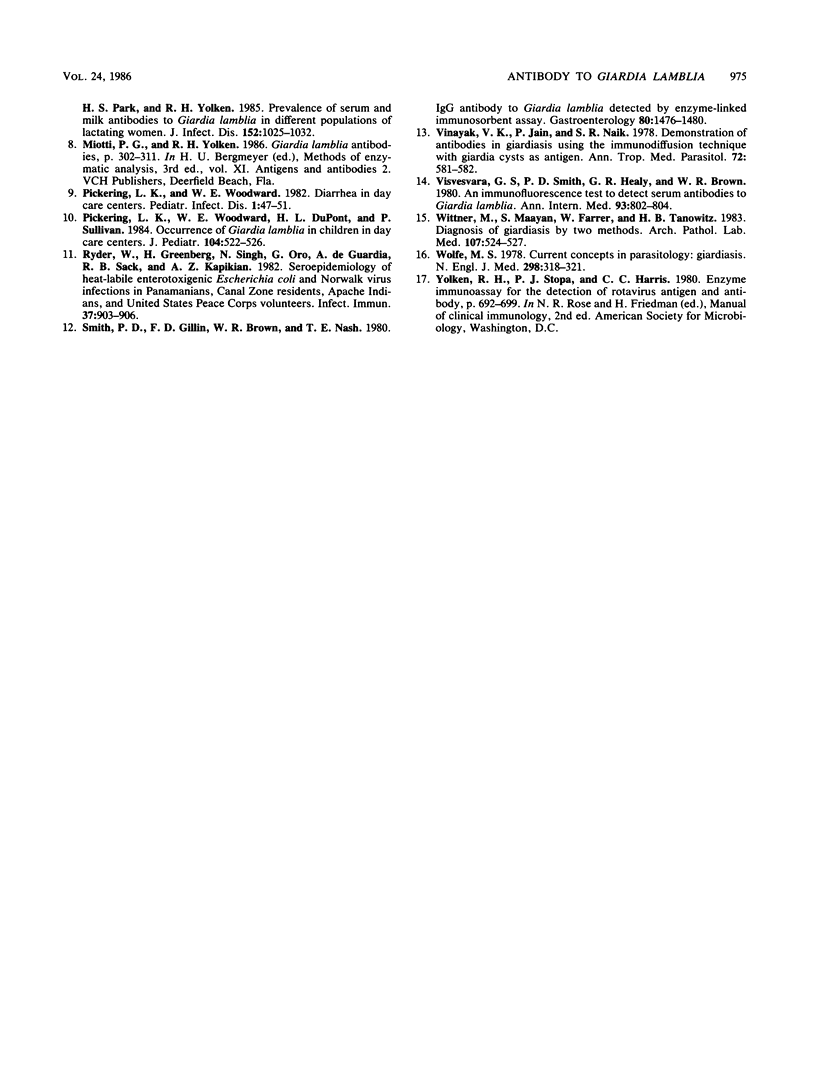Abstract
We used a solid-phase enzyme immunoassay to determine the age-specific rates of acquisition of antibody to Giardia lamblia in populations living in an inner city area of Baltimore, Md., on an Apache Indian reservation in Arizona, in a rural area of Panama, and in an urban area of Peru (Lima). Antibody to G. lamblia was found in a portion of the adults living in all of the study areas. Similar prevalence rates and quantitative levels of antibody were found in the adults living in Arizona (44%), Panama (48%), and Peru (46%). However, a significantly lower (P less than 0.05) percentage of the adults living in Baltimore (18%) displayed serological evidence of infection. Different patterns of age-associated acquisition of antibody were noted in the study populations. In the United States, children living in Baltimore had low levels of seropositivity throughout childhood, whereas children living on the Arizona Indian reservation showed a progressive acquisition of antibody early in childhood, with adult levels achieved by 8 years of age. In Latin America, children living in Panama attained adult levels of seropositivity between 9 and 20 years of age, whereas children in Peru displayed adult levels of seropositivity in the first 6 months of life. Our findings documented the widespread occurrence of G. lamblia infections in diverse populations. Children living in different areas and under different environmental conditions displayed widely differing rates of acquisition of antibody to G. lamblia, possibly resulting from different levels of sanitation, water contamination, and person-to-person contact. Our studies indicate that quantitative solid-phase immunoassays can be used to study the epidemiology of parasitic infections such as those caused by G. lamblia.
Full text
PDF



Selected References
These references are in PubMed. This may not be the complete list of references from this article.
- Burke J. A. Giardiasis in childhood. Am J Dis Child. 1975 Nov;129(11):1304–1310. doi: 10.1001/archpedi.1975.02120480030008. [DOI] [PubMed] [Google Scholar]
- Diamond L. S., Harlow D. R., Cunnick C. C. A new medium for the axenic cultivation of Entamoeba histolytica and other Entamoeba. Trans R Soc Trop Med Hyg. 1978;72(4):431–432. doi: 10.1016/0035-9203(78)90144-x. [DOI] [PubMed] [Google Scholar]
- Giardiasis and traveler's diarrhea. Gastroenterology. 1980 Jun;78(6):1602–1614. [PubMed] [Google Scholar]
- Hartong W. A., Gourley W. K., Arvanitakis C. Giardiasis: clinical spectrum and functional--structural abnormalities of the small intestinal mucosa. Gastroenterology. 1979 Jul;77(1):61–69. [PubMed] [Google Scholar]
- Islam A., Stoll B. J., Ljungström I., Biswas J., Nazrul H., Huldt G. Giardia lamblia infections in a cohort of Bangladeshi mothers and infants followed for one year. J Pediatr. 1983 Dec;103(6):996–1000. doi: 10.1016/s0022-3476(83)80739-2. [DOI] [PubMed] [Google Scholar]
- Miotti P. G., Gilman R. H., Pickering L. K., Ruiz-Palacios G., Park H. S., Yolken R. H. Prevalence of serum and milk antibodies to Giardia lamblia in different populations of lactating women. J Infect Dis. 1985 Nov;152(5):1025–1031. doi: 10.1093/infdis/152.5.1025. [DOI] [PubMed] [Google Scholar]
- Pickering L. K., Woodward W. E. Diarrhea in day care centers. Pediatr Infect Dis. 1982 Jan-Feb;1(1):47–52. doi: 10.1097/00006454-198201000-00015. [DOI] [PubMed] [Google Scholar]
- Pickering L. K., Woodward W. E., DuPont H. L., Sullivan P. Occurrence of Giardia lamblia in children in day care centers. J Pediatr. 1984 Apr;104(4):522–526. doi: 10.1016/s0022-3476(84)80540-5. [DOI] [PubMed] [Google Scholar]
- Ryder R. W., Greenberg H., Singh N., Oro G., de Guardia A., Sack R. B., Kapikian A. Z. Seroepidemiology of heat-labile enterotoxigenic Escherichia coli and Norwalk virus infections in Panamanians, Canal Zone residents, Apache Indians, and United States Peace Corps volunteers. Infect Immun. 1982 Sep;37(3):903–906. doi: 10.1128/iai.37.3.903-906.1982. [DOI] [PMC free article] [PubMed] [Google Scholar]
- Smith P. D., Gillin F. D., Brown W. R., Nash T. E. IgG antibody to Giardia lamblia detected by enzyme-linked immunosorbent assay. Gastroenterology. 1981 Jun;80(6):1476–1480. [PubMed] [Google Scholar]
- Vinayak V. K., Jain P., Naik S. R. Demonstration of antibodies in giardiasis using the immunodiffusion technique with Giardia cysts as antigen. Ann Trop Med Parasitol. 1978 Dec;72(6):581–582. doi: 10.1080/00034983.1978.11719366. [DOI] [PubMed] [Google Scholar]
- Visvesvara G. S., Smith P. D., Healy G. R., Brown W. R. An immunofluorescence test to detect serum antibodies to Giardia lamblia. Ann Intern Med. 1980 Dec;93(6):802–805. doi: 10.7326/0003-4819-93-6-802. [DOI] [PubMed] [Google Scholar]
- Wittner M., Maayan S., Farrer W., Tanowitz H. B. Diagnosis of giardiasis by two methods. Immunofluorescence and enzyme-linked immunosorbent assay. Arch Pathol Lab Med. 1983 Oct;107(10):524–527. [PubMed] [Google Scholar]
- Wolfe M. S. Giardiasis. N Engl J Med. 1978 Feb 9;298(6):319–321. doi: 10.1056/NEJM197802092980606. [DOI] [PubMed] [Google Scholar]


